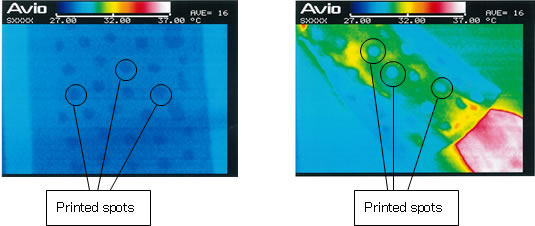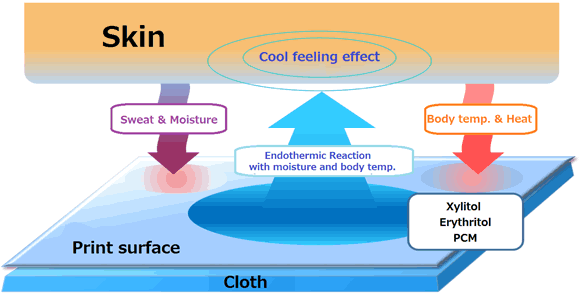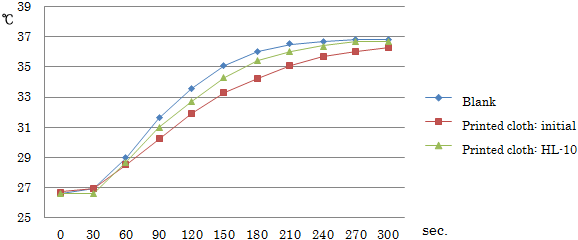PARACOOL IDP is a newly developed textile treatment agent to be used via printing,
containing such sugar alcohols as erythritol and xylitol, and paraffin
microcapsules as a phase change material (PCM). PARACOOL IDP makes use of endothermic reaction of such materials with water and heat.
That is, PARACOOL IDP printed cloth may give cooling feeling effect for wearers as it contacts
to your insensible perspiration, sweat, and body with temperatures.
PARACOOL IDP may help you creating so-called “COMFORT COOL” cloth.
| Mechanism of “cool feeling effect” by PARACOOL IDP |
|
Appearance : Milky white liquid
pH range : 5.0 ± 1.0
| PARACOOL IDP |
100 |
| PARACAT PF-5 |
2 |
| PARASOL V-20 |
2.4 |
| Total (parts) |
104.4 |
|
|
 |
Cloth: 100% cotton broad
Conditions: printing → drying110℃×3 min. → Curing130℃※×2 min.
| ※ |
Curing should be carried out with temperatures below 130℃, otherwise the
main component might be sublimated. |
| <Cool feeling effect by contact:q-max>〔J/cm2・sec〕 |
| |
Blank |
PARACOOL IDP printed cloth |
| Initial |
HL-10 |
| q-max* |
0.16 |
0.374 |
0.238 |
*Normally cool feeling effect by contact is achieved by 0.2 or more q-max
〔 Test method 〕
KES-F7 Precise and Fast Thermal Property-Measuring Instrument Thermo LabⅡ
Conditions in test room: 20℃ × 65% RH
Difference in temperature between sample and detector: 20℃
Laundry condition:JIS L-0217 No. 103 method
| <Cool feeling effect performance test:Ohara method> |
| (Time: sec.) |
Temp. (℃) |
| Blank |
Printed cloth |
| Initial |
Gap to blank |
HL-10 |
Gap to blank |
| 0 |
26.6 |
26.7 |
0.1 |
26.6 |
0 |
| 30 |
26.9 |
26.9 |
0 |
26.6 |
0 |
| 60 |
29.0 |
28.5 |
-0.5 |
26.7 |
-0.3 |
| 90 |
31.6 |
30.2 |
-1.6 |
31.0 |
-1.0 |
| 120 |
33.6 |
31.9 |
-2.0 |
32.7 |
-1.5 |
| 150 |
35.1 |
33.3 |
-1.8 |
34.3 |
-1.0 |
| 180 |
36.0 |
34.2 |
-1.8 |
35.4 |
-0.6 |
| 210 |
36.5 |
35.1 |
-1.0 |
36.0 |
-0.5 |
| 240 |
36.7 |
35.7 |
-1.0 |
36.4 |
-0.3 |
| 270 |
36.8 |
36.0 |
-0.8 |
36.7 |
-0.1 |
| 300 |
36.8 |
36.3 |
-0.5 |
36.7 |
-0.1 |
| Max. difference |
― |
-2.0 |
-1.5 |
〔 Test method 〕
| 1. |
|
Fold 10 cm × 10 cm sample in half to wrap thermo sensor, and place it in
specified conditions (25 ~ 27℃ × 40% RH) until the temperature is stabilized. |
| 2. |
|
Transfer the sample to thermo-hygrostat under the conditions of 35℃ x 90%
R, and measure the variation of temperatures every 30 seconds.
(The process simulated that a wearer went outside on a hot summer day after
stayed in a well air-conditioned room, then sweated)
Laundry condition :JIS L-0217 Method No. 103
|
| <Cool feeling effect on printed cloth visible by thermographic image> |
| After sample left at room temp. (27℃×40%RH) Then sample placed on one’s
arm |
 |
| It is visible that printed spots offered lower temperature, and the subject
was able to feel coolness as the temperature was kept lower when placing
on his/her arm. |
|
| 1. |
|
Preliminary tests should be carried out to check the effect to handling
touch and color fastness as well as compatibility with other chemicals
because the result may vary depending on conditions to be adopted. |
| 2. |
|
Printed cloth should be packed in dry state. If it is packed in wet state
(soon after pressing a steam iron), it might be whitened. |
| 3. |
|
The product is stable under normal condition. It is ideal to store it at
cool (temperatures between 5℃ and 35℃) dark place. |
| The information herein offered is based on the best of our knowledge at
present. However, we are not obliged to guarantee the matter, as the result
of application may vary depending on conditions adopted. Preliminary tests
are, therefore, recommended in all cases. Please refer to MSDS regarding
handling of the products. |
(C) copyright 2014 Venture Chemical Ltd.All Right Reserved. |
|




